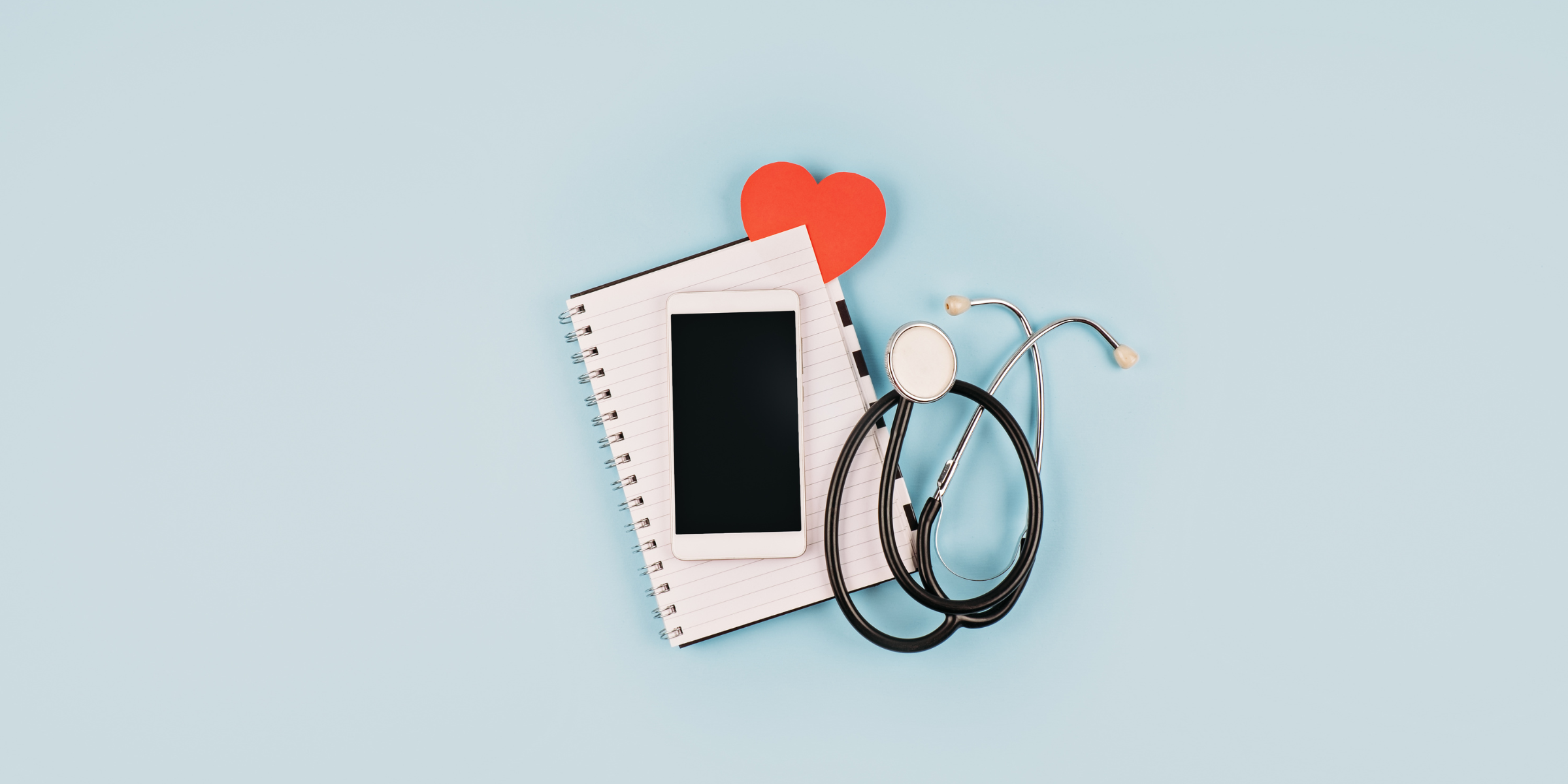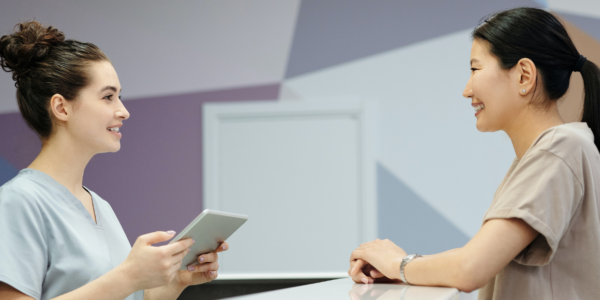Did you know that patients who feel heard and understood are more likely to adhere to treatment plans? Let’s take a moment to appreciate that. Patients who believe that their doctors care about them, listen, and prioritize patient communication are more likely to do the things their doctors tell them to improve health outcomes.
Your patients need to have certainty that they are a part of their care conversation. They need to take the driver’s seat in moving toward a positive outcome.
As a provider, if you’re not showing that you understand their needs, why would they listen to you?
Whether you’re a seasoned healthcare provider or just starting out, this post will provide you with actionable tips on how to master physician communication with your patients that goes beyond the typical in-office visit or phone call.
Strategies to Master Patient Communication
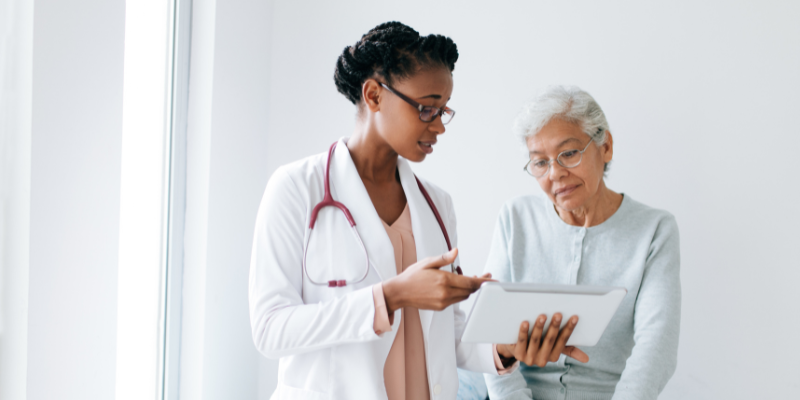
R-E-S-P-E-C-T Find out what it means to…your patient.
To master patient communication in the evolving digital space, there are many tools we can take from the traditional face-to-face interaction.
One model that healthcare providers have widely accepted is the RESPECT model. This model is used to promote a clinician’s awareness of their own cultural biases and to develop their interaction with patients.
We’ll get into how the model might apply in a digital engagement, but first it’s important to understand how the model’s seven elements come into play in the traditional, face-to-face doctor/patient interaction.
Imagine Maria, a patient who has just moved to a new city and is coming in for her yearly physical with Dr. Lee, a healthcare provider known for his commitment to effective patient communication.
Rapport
From the moment Maria enters the clinic, Dr. Lee builds rapport by welcoming her with a warm smile, introducing himself, and using her name to make her feel at ease in the unfamiliar setting.
Empathy
As they begin discussing her health, Dr. Lee demonstrates empathy by listening intently to Maria’s concerns about her recurring migraines, acknowledging how challenging it must be to deal with such pain, especially in the midst of relocating.
Support
He offers support by assuring her that they will explore all possible treatments to manage her condition and provides her with educational materials about migraine triggers and prevention.
Partnership
Understanding the importance of partnership, Dr. Lee involves Maria in the decision-making process, explaining the benefits and side effects of various medications and lifestyle changes that could alleviate her symptoms.
Explanations
He makes sure that explanations are given in a straightforward manner, ensuring Maria fully understands her options and feels comfortable asking questions.
Cultural competence
Recognizing the significance of cultural competence, Dr. Lee inquires about any home remedies or traditional practices Maria might be considering, showing respect for her cultural background and incorporating her beliefs into the treatment plan.
Trust
Throughout their interaction, trust grows as Maria feels genuinely cared for, heard, and valued. Dr. Lee’s openness and honesty, combined with his commitment to understanding Maria as an individual, not just a patient, ensure that she leaves the clinic feeling confident in her care plan and secure in the knowledge that she has a partner in her health journey.
The RESPECT Model in patient texting
The beauty of these tried and true methodologies for effective patient interaction is that nearly all of them carry over into the digital space. If the building of trust is crucial for improving patient health outcomes, then it’s extremely important to apply the same RESPECT principles, regardless of the communication medium.
Let’s look forward in the timeline after Maria leaves her appointment with Dr. Lee. What might this look like in a text message conversation?
Rapport
Maria initiates the conversation via SMS message to the practice’s textable phone number, “Hi Dr. Lee, it’s Maria. I’ve been thinking about the discussion we had during my physical and I have a question.” Dr. Lee responds promptly, “Hello Maria! It’s great to hear from you. What’s on your mind? I’m here to help.” This exchange sets a friendly tone, maintaining the rapport they built in person.
Empathy
Maria expresses her apprehension about the new migraine medication’s potential side effects. Dr. Lee replies, “I understand your concerns, Maria. It’s completely normal to feel uneasy about starting a new treatment. Let’s go through your concerns together.” His response demonstrates empathy, acknowledging her feelings and reassuring her that her worries are valid.
Support
To offer support, Dr. Lee texts, “Remember, we’re here to help. If the side effects become bothersome or if you have any questions, I want you to feel comfortable reaching out to me directly.” This message reinforces his commitment to her well-being and ensures Maria knows she has his support.
Partnership
Dr. Lee continues, “Would you be open to keeping a diary of how you feel while on the medication? It can help us both understand how you’re responding to the treatment and make any necessary adjustments.” By suggesting a joint activity, he fosters a sense of partnership, involving Maria actively in her care.
Explanations
Understanding the importance of clarity, especially in text format, Dr. Lee provides a concise yet thorough explanation of how the medication works, its common side effects, and why he believes it’s a good option for her. “I’ve chosen this medication because it has shown great results for patients with similar migraine patterns. Here’s what you might expect…”
Cultural competence
Aware of Maria’s interest in holistic approaches, Dr. Lee asks, “How do you feel about integrating some lifestyle changes or natural supplements along with your medication? I remember you mentioned an interest in holistic health.” This shows his respect for her cultural and personal health preferences.
Trust
Closing their conversation, Dr. Lee affirms, “Maria, I’m here to answer any questions or to adjust your treatment plan as needed. Your health and comfort are my top priorities.” This assurance fosters trust, ensuring Maria feels secure in her healthcare journey.
A shared mission for the practice care team
Not every practitioner is going to have the luxury of engaging in conversation immediately every time a patient reaches out. This is why creating a shared mission for patient engagement is important.
Using models like RESPECT, you have the ability to set a standard for how all the members of the team interact with patients so that the ways in which you engage, your tone, your voice, your empathetic nature, shines through.
Additional tips to boost patient communication for patients
Using plain language and avoiding medical jargon is another crucial strategy to improve patient understanding. This ensures that patients can comprehend their medical condition and treatment options without confusion.
Encouraging patients to ask questions, providing additional information, and addressing their concerns are key communication strategies that empower patients to actively participate in their healthcare journey. Open lines of communication between patient and provider will give them space and confidence to follow-up and gain clarity even after the appointment is over.
Other proven communication models to consider in your practice
Another effective model you might consider implementing is shared decision-making, where both healthcare providers and patients collaborate to make treatment decisions. This approach ensures that patients are actively involved in their healthcare journey, leading to significantly improved patient satisfaction. Cognitive interview techniques help healthcare providers gather accurate medical information from patients, facilitating accurate diagnosis and treatment.
The teach-back model promotes patient education and ensures their understanding of medical information by asking the patient to share what they learned back to their provider. By testing out and implementing evidence-based communication models, healthcare providers can create a positive and mutually beneficial environment for patients, ultimately improving clinical outcomes and overall healthcare experiences.
Again, the great part of these models is that you can implement them whether or not you are in person or connecting asynchronously through a digital channel.
Leveraging Technology for Effective Communication
Telehealth and video conferencing have made it possible for healthcare providers to reach and communicate with patients remotely, ensuring increased access to care. Through the use of technology, healthcare providers can efficiently share medical records, test results, and treatment options, leading to more streamlined and effective communication. By embracing technology for communication, healthcare providers can ultimately improve patient outcomes, enhance the patient experience, and elevate the overall quality of healthcare.
There are many platforms to choose from, of course, but two things should always be considered when vetting a new software.
- Is the software HIPAA compliant?
- Is it easy to implement?
OhMD, for example, checks both of the boxes. When it comes to HIPAA compliance, the patient communication platform offers the best of both worlds as it requires a patient’s consent to text, or can send messages via encrypted link delivered by text. Depending on the provider and patient’s comfort level and the level of security needed, they can switch back and forth between the options.
Additionally, OhMD, as a patient messaging solution, leads with text messaging, a communication medium 99% of the world already uses. It lets the provider text enable their main phone line, which makes it easier for patients to recognize who is reaching out to them, and it also is inclusive of a bunch of different communication tools. For example, OhMD offers both two-way patient texting, but it also offers video visits, and outbound patient calls.
So if you’re texting with someone, and they need a visual tutorial for something, its super simple to hop on a video call. Have a patient that prefers a phone call over a text message, call them right from the platform.
Whatever the medium, everything is documented in the patient conversation record.
Practices love OhMD. Patients love how easy it is to connect. It’s the perfect system for patient conversations and, as a bonus, most practices can be up and running within a week.
This said, the key takeaways when vetting your patient communication software are to ensure data security and that your staff and patients will use it.
Understanding the Importance of Patient Communication
Effective patient communication is crucial for improved clinical outcomes and better patient adherence to treatment plans. Healthcare providers need clear communication skills to understand the needs and concerns of their patients. In addition, patient education relies heavily on effective communication to provide medical information in an easily understandable manner. The National Academy of Medicine recognizes the significance of communication in healthcare settings – it’s associated with better outcomes.
By employing effective communication skills, healthcare professionals can establish a rapport with patients, allowing for open and honest dialogue. Through clear communication, medical terms can be explained, concerns can be discussed, and additional questions can be addressed. This allows providers to get a more comprehensive picture of a patient’s medical history, provide an accurate diagnosis, and achieve better clinical outcomes. Moreover, effective patient communication involves paying attention to non-verbal cues such as facial expressions, which can help healthcare providers detect patient discomfort or distress and respond appropriately.
Overall, understanding and practicing effective communication skills is essential in providing quality healthcare and enhancing the patient experience. It promotes collaboration between healthcare professionals and patients, leading to improved treatment outcomes, patient satisfaction, and overall healthcare delivery.
How OhMD Improves Efficiency in Communication
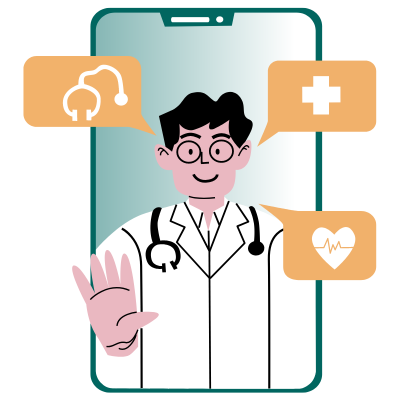
OhMD, a HIPAA-compliant communication platform, plays a crucial role in enhancing patient messaging. It allows healthcare providers to securely exchange messages, phone calls, and sensitive information with patients. The streamlined two-way communication process offered by OhMD also saves valuable time for healthcare providers, making their workflow more efficient. Through effective communication facilitated by OhMD, healthcare providers can establish a mutual understanding with patients, leading to better clinical outcomes.
Additionally, the platform helps overcome communication barriers and reduces breakdowns, ensuring that important medical terms, test results, and decision-making processes are effectively conveyed to patients. With its wide range of benefits, OhMD is a valuable tool for healthcare providers to enhance their conversations with patients and improve overall patient care.
With OhMD, healthcare providers can communicate with multiple patients simultaneously, saving time and resources. This streamlined approach allows providers to send patient education materials, treatment plan updates, and reminders all in one communication, eliminating the need for multiple phone calls or separate messages. By replacing traditional communication methods, such as phone calls, with OhMD’s secure messaging system, healthcare providers can communicate faster and more conveniently. Prompt responses to patient questions and concerns reduce wait times and ensure a more positive patient experience.
With OhMD Broadcast, providers can maximize efficiency by sending dozens of personalized messages – but only writing one. Take a template you’ve already written and use live fields to make the message custom to each patient, letting the system fill in variables like patient name or appointment time.
Enhancing the Patient Experience with OhMD
OhMD revolutionizes patient communication, resulting in an enhanced patient experience. By providing a convenient and timely means of communication between patients and healthcare providers, OhMD empowers patients to actively engage in their care. They can easily ask questions, share concerns, or provide updates, promoting better patient-provider communication.
The patient-centered approach of OhMD fosters personalized and responsive communication, ultimately improving patient satisfaction. Healthcare providers can use OhMD to provide patient educational materials and utilize communication techniques by using the application. Through this platform, healthcare providers can address medical problems, discuss differential diagnoses, and answer additional questions, all while ensuring mutual understanding. OhMD streamlines communication, enabling care providers to offer effective medical care and clinical outcomes.
The Power of One-to-Many Messaging with OhMD
One-to-many messaging with OhMD offers healthcare providers a powerful tool to efficiently communicate important information to a large patient population. With just a few clicks, providers can send messages, updates, and reminders to multiple patients simultaneously, saving valuable time. Broadcast is particularly beneficial for reaching out to patients for preventive care, health campaigns, or general education.
Consider how much time it would take to send 100, or even 50 individual patient reminders. We’ve seen the benefits of utilizing patient reminders, and how it can mitigate no-shows. But how can we make this more efficient?
By utilizing one-to-many messaging, healthcare providers can proactively stay connected with their patients, fostering a stronger patient-provider relationship. Whether it’s sending health tips, appointment reminders, or educational materials, OhMD enables providers to make communication more proactive and personalized.
Measuring the Effectiveness of Patient Communication
Effective patient communication plays a crucial role in improving overall healthcare outcomes. Healthcare providers with good communication skills can establish rapport and trust with their patients, leading to better adherence to treatment plans. When healthcare professionals communicate clearly and effectively, patients have a greater understanding of their medical information, including diagnoses and treatment options. This understanding promotes mutual understanding between patients and care providers, facilitating shared decision-making and ensuring that patients are actively involved in their own healthcare decisions.
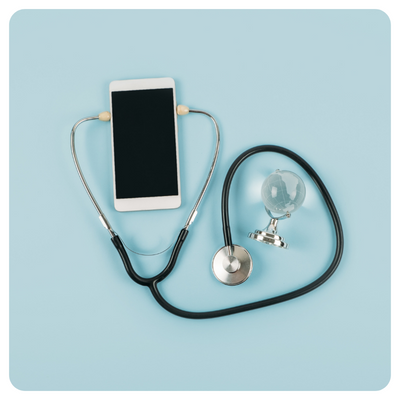
Furthermore, effective communication reduces the risk of medical errors and improves patient safety. Clear communication helps prevent misunderstandings or misinterpretations of medical terms and instructions, which can be detrimental to patients’ health. By utilizing effective communication skills, healthcare providers can ensure that patients feel heard, valued, and supported throughout their medical journey.
Overall, measuring the effectiveness of patient communication is vital for enhancing clinical outcomes, patient satisfaction, and healthcare quality. It allows healthcare providers to identify areas for improvement and implement strategies that promote effective messaging, ultimately leading to improved patient experiences and positive health outcomes.
How OhMD has Transformed Patient Communication
OhMD has completely revolutionized patient communication in healthcare. By securely communicating through text messaging, providers and patients can save time and easily address questions, prescription refills, and test results. This promotes effective and timely communication, enhancing the overall patient experience. Conversations are the crux of patient care, and an open channel of messaging will enable that. Tools like Broadcast let providers send one-to-many messages for things like appointment or billing reminders.
Physician communication with patients plays a crucial role in providing quality healthcare and improving patient outcomes. It not only enhances the patient experience but also increases efficiency in clinical workflows. OhMD is a powerful tool that allows healthcare providers to streamline communication, saving valuable time and resources. With features like one-to-many messaging, healthcare professionals can easily reach multiple patients simultaneously, ensuring timely and consistent communication. By implementing proven communication models and leveraging technology like OhMD, healthcare providers can master patient messaging and deliver the highest standard of care. Furthermore, OhMD’s ability to measure the effectiveness of communication enables providers to continuously improve their communication strategies and adapt to the ever-changing healthcare landscape.
